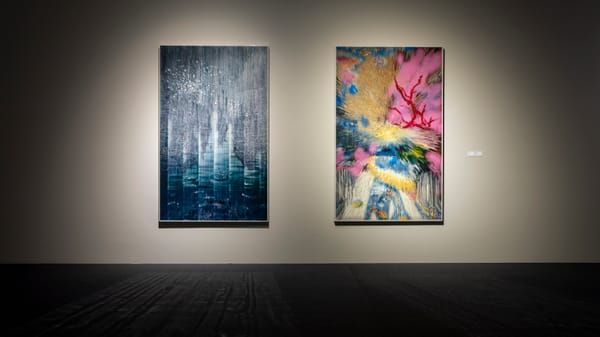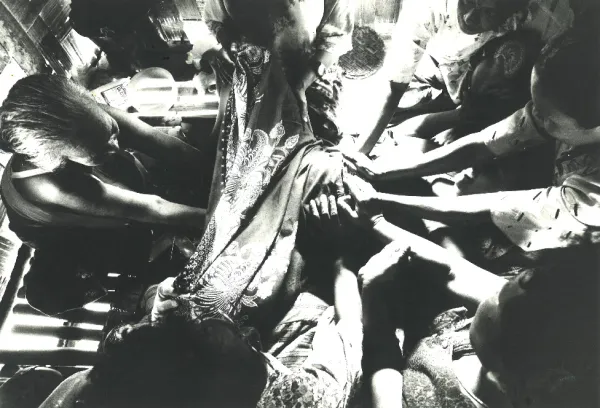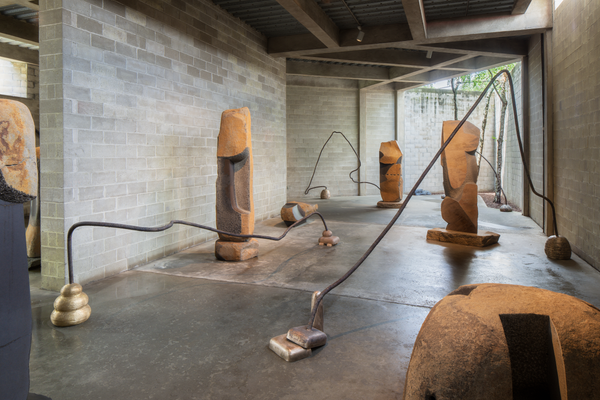Shows
“Khalas”


The ever-growing artist collective eleven was formed in July 2016 to bring together contemporary Muslim artists practicing in Australia, and to encourage cross-cultural dialogue. Ten of its artists were represented in the exhibition “Khalas” at Sydney’s University of New South Wales Galleries. The Arabic word “Khalas” has several meanings, including "stop," "finish," "that’s all," "it’s fine" and "enough." Given the continued vilification experienced by Muslims in Australia—a country still held up by its politicians as the most multicultural nation in the world—it's a wonder we are all not more familiar with the term, chosen by co-curators Phillip George and Nur Shkembi as the show’s title to convey the sentiment: enough is certainly enough.

Through a variety of mediums—video, photography, sculpture and installation—the group interrogates the issue of Muslim identity, religion and politics within contemporary culture and tradition. Most of the artists featured employ persuasion rather than coercion, except for Abdul Abdullah, who deals with perceived Islamophobia head-on in his self-portrait Journey to the West (2017), which sees him donning an ape mask from the 2001 movie Planet of the Apes and occupying the center of a stage set for a traditional Malaysian wedding. He becomes the monster, the Other, the Muslim to be feared. His brother Abdul-Rahman, on the other hand, takes a broader social perspective in his sculpture We Know Who Did It (2014), a charred wooden television set that references a 2013 act of arson at a high school in western Sydney, where, through a series of workshops, the pupils came to define the act of arson as one of resistance against authority.
Decidedly unconfrontational is the delicately rendered, mixed-media-on-paper When they Walk, I Walk, When they Stop, I Stop (2017) by Mehwish Iqbal. Through a highly refined aesthetic language of layered textiles and embroidery, the artist tells the story of a Syrian refugee who, with his two children, walking through a harsh European winter in search of a place to stay, says he will only stop when the group stops, demonstrating that collective identity is stronger than the individual.
There were several standout works, including Khadim Ali’s richly decorative textile piece, The Arrivals (2016), which hung from a wall. The three-dimensional, bearded and horned heads that protrude from the carpet are metamorphosed demons who, as Ali has said previously, are seen as being beyond humanity. With a backdrop of eucalyptus leaves inspired by Australian passport imagery, the allusion to the demonization of Australian asylum seekers is obvious.
Collective identity and its resilience was at the core of this exhibition and nowhere more so than in Hoda Afshar’s studio photographic portrait series of chador-wearing Muslim women, titled Westoxicated # 5, 7, 1, 3 and 9 (2013–14), which appropriate the vivid coloration of Warhol-esque Pop Art. Far from being the stereotypical, oppressed Muslim women seen through the white gaze, the figures of Afshar’s images are fashion-loving, rebellious, and above all, liberated.
This sense of liberation is also seen in Leila el-Rayes’s sensual, single-channel video, Dancing in the Crevice of Desire (2016), which deals with the dual states of visibility and invisibility experienced by Muslim women who wear the chador. Completely wrapped in vividly colored material inspired by the rich patterns of Islamic imagery, she dances in front of a matching background, thereby appearing and disappearing simultaneously.
But perhaps the star of the show was Khaled Sabsabi’s Syria (2012), a two-channel, 20-minute video filmed in Syria over seven years from 2004 to 2011, prior to and during the Arab Spring movements across North Africa and the Middle East. Using film-editing techniques, Sabsabi skillfully transforms multiple street scenes—people walking and vehicles moving—captured from a bird’s-eye view, into colorful, kaleidoscopic patterns that evoke the geometry of Islamic decorations such as porcelain tiles. He later confirmed that the symmetry of much Islamic art has long fascinated him.
“Khalas” was a timely exhibition for Australia, but where outcomes, I suspect, will be limited. Expecting art to bring about social change and dismantle prejudice is a tall order. Whether it will achieve any of its stated aims remains to be seen in a country where hedonism and sport are the dominant preoccupations, and where Australians prefer their incoming refugees to be kept firmly out of sight. Even so, “Khalas” was a gentle, seductive and engaging exhibition with a hefty undercurrent of political agency that assaults the viewer with visceral strength, while negotiating the numerous issues of multiculturalism.
Michael Young is a contributing editor of ArtAsiaPacific.
“Khalas” is on view at the University of New South Wales Galleries, Sydney, until July 14, 2018.







